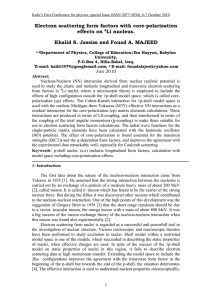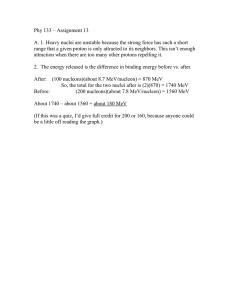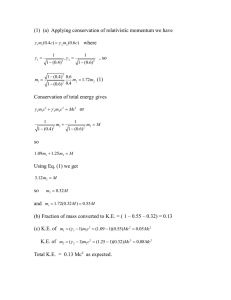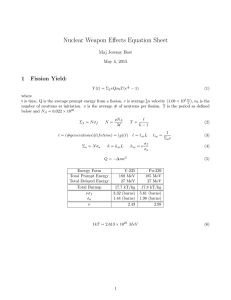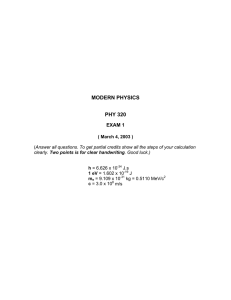Electron scattering form factors with core- polarization effects on Li nucleus.
advertisement
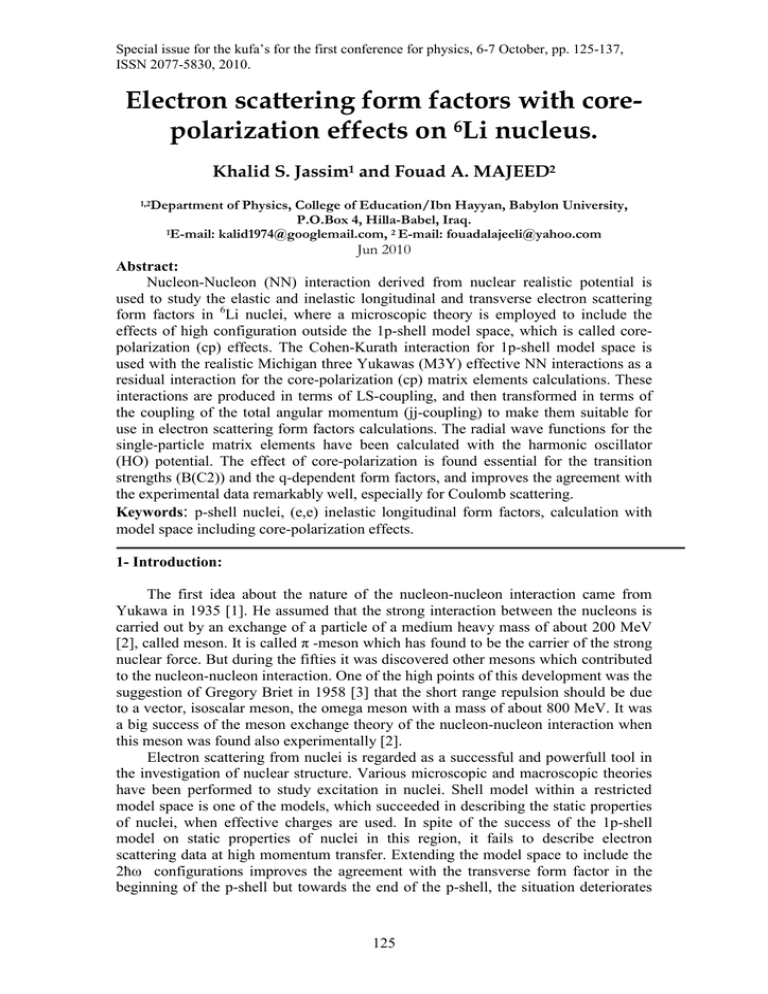
Special issue for the kufa’s for the first conference for physics, 6-7 October, pp. 125-137, ISSN 2077-5830, 2010. Electron scattering form factors with corepolarization effects on 6Li nucleus. Khalid S. Jassim1 and Fouad A. MAJEED2 1,2Department of Physics, College of Education/Ibn Hayyan, Babylon University, P.O.Box 4, Hilla-Babel, Iraq. 1E-mail: kalid1974@googlemail.com, 2 E-mail: fouadalajeeli@yahoo.com Jun 2010 Abstract: Nucleon-Nucleon (NN) interaction derived from nuclear realistic potential is used to study the elastic and inelastic longitudinal and transverse electron scattering form factors in 6Li nuclei, where a microscopic theory is employed to include the effects of high configuration outside the 1p-shell model space, which is called corepolarization (cp) effects. The Cohen-Kurath interaction for 1p-shell model space is used with the realistic Michigan three Yukawas (M3Y) effective NN interactions as a residual interaction for the core-polarization (cp) matrix elements calculations. These interactions are produced in terms of LS-coupling, and then transformed in terms of the coupling of the total angular momentum (jj-coupling) to make them suitable for use in electron scattering form factors calculations. The radial wave functions for the single-particle matrix elements have been calculated with the harmonic oscillator (HO) potential. The effect of core-polarization is found essential for the transition strengths (B(C2)) and the q-dependent form factors, and improves the agreement with the experimental data remarkably well, especially for Coulomb scattering. Keywords: p-shell nuclei, (e,e) inelastic longitudinal form factors, calculation with model space including core-polarization effects. 1- Introduction: The first idea about the nature of the nucleon-nucleon interaction came from Yukawa in 1935 [1]. He assumed that the strong interaction between the nucleons is carried out by an exchange of a particle of a medium heavy mass of about 200 MeV [2], called meson. It is called π -meson which has found to be the carrier of the strong nuclear force. But during the fifties it was discovered other mesons which contributed to the nucleon-nucleon interaction. One of the high points of this development was the suggestion of Gregory Briet in 1958 [3] that the short range repulsion should be due to a vector, isoscalar meson, the omega meson with a mass of about 800 MeV. It was a big success of the meson exchange theory of the nucleon-nucleon interaction when this meson was found also experimentally [2]. Electron scattering from nuclei is regarded as a successful and powerfull tool in the investigation of nuclear structure. Various microscopic and macroscopic theories have been performed to study excitation in nuclei. Shell model within a restricted model space is one of the models, which succeeded in describing the static properties of nuclei, when effective charges are used. In spite of the success of the 1p-shell model on static properties of nuclei in this region, it fails to describe electron scattering data at high momentum transfer. Extending the model space to include the 2ћω configurations improves the agreement with the transverse form factor in the beginning of the p-shell but towards the end of the p-shell, the situation deteriorates 125 Special issue for the kufa’s for the first conference for physics, 6-7 October, pp. 125-137, ISSN 2077-5830, 2010. [4]. The effective interaction is used to understand nuclear properties microscopically, starting with realistic NN interaction and using mechanical many-body theory. For light nuclei, there are several “standard” effective interactions such as the CohenKurath [5] interactions for 1p-shell. The concept of the core-polarization effects has been introduced in order to account for the participation of configurations from outside of the model space in the transition. Core-polarization effects are taken into account through first order perturbation theory, which allows particle-hole excitation from the 1s-shell core orbits and also from the valence 1p-shells to the higher allowed orbits with 2ћω excitations. The goal of study is to use the realistic effective nucleon-nucleon (NN) interaction as a residual interaction to calculate the core-polarization (cp) effects through a microscopic theory which combines shell model wave functions and highly excited states. We will discuss the core-polarization effects on the elastic and inelastic electron scattering form factors for the low lying states of 6Li nuclei. The CK wave functions will be adopted as the zeroth-order wave functions. The NN interaction adopted in the present study is a realistic interaction between two nucleons; it is expressed as a sum of three parts, central potential part, spin-orbit potential part, and tensor potential part. This interaction is used as the residual interaction between nucleons in the core, and nucleons excited to higher orbits. The theoretical part of the present work includes the formulations of the elastic and the inelastic electron scattering and will be performed in chapter two. The derivation of cp effects with higher configuration in the first order perturbation theory and the two-body matrix elements of three part of the realistic interaction: central, spin orbit and strong tensor force will be introduced in chapter three, where the two-body matrix elements calculation in harmonic oscillator single-particle basis using Moshinisky transformation. The results, discussions and conclusion will be demonstrated in chapter four. 2-Theory: The reduced matrix elements of the electron scattering operator TˆΛη consist of two parts, one is for the "Model space" matrix elements, and the other is for the "Corepolarization" matrix elements [6]. Γ f TˆΛη Γi = Γ f TˆΛη Γi + Γ f δTˆΛη Γi MS Where the state Γi and Γf . (1) CP are described by the model-space wave functions. Greek symbols are used to denote quantum numbers in coordinate space and isospin, i.e. Γi ≡ J i Ti , Γ f ≡ J f T f and Λ ≡ JT . The model space (MS) matrix elements are expressed as the sum of the product of the one-body density matrix elements (OBDM) times the single-particle matrix elements, which is given by: (2) Γ Tˆ η Γ = OBDM (α , β ) α Tˆ η β f Λ ∑ i MS α ,β Λ MS 126 Special issue for the kufa’s for the first conference for physics, 6-7 October, pp. 125-137, ISSN 2077-5830, 2010. where α and β denote the final and initial single particle states respectively (isospin is included) for the model space. Similarly, the core-polarization matrix element in equation (1) can be written as follows: Γ f δTˆΛη Γi = ∑ OBDM (α , β ) α δTˆΛη β cp (3) α ,β cp According to the first order perturbation theory, the single-particle matrix element for the higher-energy configurations is given by [7]: α δTˆJη β = α Vres Q ˆη β + α Tˆη Q V β T J J res E − H (0) E − H (0) (4) The operator Q is the projection operator onto the space outside the model space. For the residual interaction, Vres, we adopt the M3Y [G. Bertsch, J. Borysowicz and H. McManus]. Ei and Ef are the energies of the initial and final states, respectively. Equation (4) is written as [7] β +α + Γ α δTˆΛ β = α 1 (−1) 2 ∑ ,α ,Γ eβ − eα − eα + eα 2 1 2 α (2Γ + 1) × α 2 × αα Vres βα 2 × α TˆΛη α × (1+δα α )(1+δα β ) 1 Γ 1 2 1 exchanged with an overall minus sign, β Λ α1 Γ + terms with α 1 and α 2 2 (5) where the index α 1 runs over particle states and α 2 over hole states and e is the single –particle energy. The core-polarization parts are allowing particle-hole excitations from the 1s-, 1p- and 2s1d-shell orbits into higher orbits. These excitations are taken up to 4 ηω . The reduced single particle matrix element becomes: η α 2 TˆJT β1 = 2T + 1 η ∑ I T (t z ) α 2 TˆJt z α 1 2 t (6) z where: for T = 0 1 I T (t z ) = 1 − t z for T =1 (−1) 2 (7) where tz 1/2 for proton and -1/2 for a neutron. Electron scattering form factor involving angular momentum J and momentum transfer q, between the initial and final nuclear shell model states of spin Ji,f and isospin Ti,f are [8] 127 Special issue for the kufa’s for the first conference for physics, 6-7 October, pp. 125-137, ISSN 2077-5830, 2010. 2 FJη (q) = T f 4π T f −Tzf ( − 1 ) ∑ Z 2 (2 J i +1) T =0,1 −T Zf 2 × Fc.m (q) × F f .s (q) 2 M T T Zi T Ti 2 Γ f TJη,T (q) Γi (8) where Tz is the projection along the z-axis of the initial and final isospin states and is given by tz= (z-n)/2. The nucleon finite size (fs) form factor is Ffs(q) = exp (-o.43q2/4) and Fcm(q) = exp (q2b2/4a) is the correction for the lack of translation invariance in the shell model. A is the mass number and b is the harmonic oscillator size parameter. The single-particle energies are calculated according to [7]: 1 − ( l +1 ) f ( r ) 2 enlj =( 2n +l − 1 )ηω+ 2 1l f ( r ) nl 2 with: f(r ) nl 1 nl for j =l − 2 (9) for j =l + 1 2 ≈ 20 A− 2 / 3MeV (10) ηω= 45 A −1 / 3 − 25 A− 2 / 3 For the two-body matrix elements of the residual interaction αα 2 Vres βα 1 Γ , which appear in equations (5), the Michigan three Yukawas (M3Y) interaction of Bertch et. al [9] is adopted. The interaction is taken between a nucleon in any coreorbits and nucleon that is excited to higher orbits with the same parity and with the required multipolarity ( Λ ), and also between a nucleon in any sd orbits and that is excited to higher orbits with the same parity and with the required multipolarity. The form of the potential is defined in equations (1)-(3) in ref. [9]. The parameters of “Elliot” are used which are given in table 1 of the mentioned reference. This interaction was given in LS-coupling. A transformation between LS and jj must be performed to get the relation between the two-body shell model matrix elements and the relative and center of mass coordinates, using the harmonic oscillator radial wave functions with Talmi-Moshinsky transformation. 3- Result and discussion The 6Li nucleus is especially interesting nuclei because is the lightest state nuclei that contain p-shell nucleons. The structure and properties of 6Li nucleus are experimentally and theoretically well studied (especially form factors are of particular interest). For the conventional many particles shell model, the 6Li nucleus is essentially a three-body system, two valence nucleons distributed over 1p3/2-1p1/2 shell and presumably inert 4He core. The HO single-particle wave function is employed with size parameter b=1.88 fm [10]. This nucleus is important to be studied because both longitudinal and transverse form factors have been measured for the transitions to five states: M1, 0.0 MeV (1+ 0) state C0+C2, 0.0 MeV (1+ 0) state 128 Special issue for the kufa’s for the first conference for physics, 6-7 October, pp. 125-137, ISSN 2077-5830, 2010. C2, 2.18 MeV (3+0) state M1, 3.56 MeV (0+1) state M1+E2+M3, 5.37 MeV (2+1) state 3-1 The Elastic Magnetic Form Factor for 1+0 State The elastic magnetic form factor M1 is a purely isoscalar, which is defined in this case practically by a single M1 multipole, and is described in terms of two nucleons outside a closed 1s–shell. The magnetic form factor carries information about the distributions of magnetization current and of convection current over nuclear volume [11]. Fig. (4-2-1) shows the transverse M1 electron scattering form factor as a function of momentum transfer q. The dashed curve represents the results of the form factor for 1p-shell model, and the solid curve represents the contribution of 1p-shell model with core-polarization effect. It is noticed from Fig. (1), that the inclusion of the core-polarization doesn’t affect significantly the calculation of the form factors especially at the first maximum region (q < 1.5) fm-1, and experimental data [12, 13] are well described in this region. While, in the second maximum region, we noticed that the cp affecting toward reducing the form factor with the rate of meager and not sufficient to predicate the experimental data. The OBDM elements are given in table (1). Table (1): The values of the OBDM elements for the transverse M1 + transition of the 1 0 ground state of 6Li. Ji 1/2 1/2 3/2 3/2 Jf 1/2 3/2 1/2 3/2 OBDM (∆T=0)) -2.261687E-01 3.287066E-01 -3.287066E-01 5.186325E-01 129 Special issue for the kufa’s for the first conference for physics, 6-7 October, pp. 125-137, ISSN 2077-5830, 2010. 1.0E-3 6 Li M1: 0.0 MeV (1+ 0) 1p+cp 1.0E-4 1p |F(q)|2 Exp. Exp. 1.0E-5 1.0E-6 1.0E-7 0.00 0.50 1.00 1.50 2.00 2.50 3.00 3.50 -1 q(fm ) Fig.(1) Elastic M1 transverse form factor for the 1+0 state in 6Li, with and without core-polarization effects. The experimental data are taken from refs. [13] (Squares) [12] (circles). 3.2 The Elastic Longitudinal Form Factor For 1+0 state The elastic charge form factors for the 1p-shell model calculation for this transition are illustrated in Fig. (2). The total form factors for this transition are considered as the sum of the C0 and C2 (as a solid curve). The C2 has not been studied experimentally because of its smallness, although it deserves undoubtedly to be studied in detail because it yields straightforward information about the small Dcomponent of 6Li ground state [11]. And also the multipoles C0 and C2 cannot be separated experimentally, so only the sum of these squares FL2 (q ) = FC20 (q ) + FC22 (q ) is measured. Fig. (3) shows a comparison between the calculated form factors with the inclusion of cp effect (as a solid curve) and those of 1p-shell model calculation (as a dashed curve). The cp effects enhance the C2 form factor appreciably by a factor around 3 over the 1p-shell calculation. The results of the 1p-shell model calculation (without cp effect) give a good agreement with the experimental data [85] up to the momentum transfer q =2.35 fm-1. The inclusion of cp effects enhances the C2 form factor appreciably, but due to its small contribution to the total form factor in the region of q < 2 fm-1, it does not affect the total form factor. The OBDM elements for these cases are shown in tables (2) and (3). Table (2): The values of the OBDM elements for the longitudinal transition C0 of + the 1 0 ground state of 6Li. 130 Special issue for the kufa’s for the first conference for physics, 6-7 October, pp. 125-137, ISSN 2077-5830, 2010. 6 Initial State 1s1/2 Li C0 Final State 1s1/2 OBDM (∆T=0) 3.4641 1p1/2 1p1/2 5.969991E-1 1p3/2 1p3/2 8.018578E-1 Table (3): The values of the OBDM elements for the longitudinal + transition C2 of the 1 0 ground state of 6Li . 6 Li C2 Ji Jf OBDM (∆T=0)) 1/2 3/2 -1.909589E-1 3/2 1/2 1.909589E-1 3/2 3/2 7.155285E-2 1E+0 6 Li C0+C2: 0.0 MeV (1+, 0) 1E-1 1p C0 1E-2 C2 Exp. |F(q)|2 1E-3 1E-4 1E-5 1E-6 1E-7 0.00 0.50 1.00 1.50 2.00 2.50 3.00 3.50 -1 q(fm ) Fig. (2) Coulomb C0+C2 form factor for the transition to the 1+0 ground state in 6Li, without core-polarization effects. The experimental data are taken from ref. [11]. 131 Special issue for the kufa’s for the first conference for physics, 6-7 October, pp. 125-137, ISSN 2077-5830, 2010. 1E+0 6 Li C0+C2: 0.0 MeV (1+0) 1E-1 1p+cp 1p C2 (1p+CP) 1E-2 C2 (1p) |F(q)|2 Exp. 1E-3 1E-4 1E-5 1E-6 1E-7 0.00 0.50 1.00 1.50 2.00 2.50 3.00 3.50 q(fm-1) Fig. (3) Coulomb C0+C2 form factor for the transition to the 1+0 ground state in 6Li, with and without core-polarization effects. The experimental data are taken from ref. [11]. 3-3 The 2.18 MeV (3+0) State π The nucleus is excited by the incident electron from the ground state ( J i Ti = 1+0) π to the state J f T f =3+0 with an excitation energy of 2.18 MeV. The OBDM elements values for the C2 transition are listed in table (4). The longitudinal C2 form factor is of isoscalar character. The experimental data for this transition are available [14,15]. In 1p-shell model, the calculated form factors underpredict the data in all regions of the momentum transfers q, as shown in Fig. (4), as a dashed curve. In this model only the model space wave functions are considered. The 1p-shell model fails to describe the data in both the transition strength and the form factors. The calculated B(C2 ↑ ) value is 6.02 e2 fm4 which is low in comparison with the measured value 21.7 ± 4.9 e2 fm4 [16]. Core-polarization effects enhance the form factor and reproduce the measured form factor up to q=2 fm-1, as shown by the solid curve of Fig (4). In this case the calculated B(C2 ↑ ) value is 16.68 e2 fm4, which is nearly close to the measured value. A similar result is obtained by using MSDI potential [17,18]. Cluster model calculation [19] reproduced the data for q < 1 fm-1 and overestimated the data for higher q values. Good agreement is obtained by the variational Monte Carlo calculation [20]. Table (4): The values of the OBDM elements for the longitudinal + C2 transition to the 3 0 at 132 E x =2.18 MeV for 6Li. Special issue for the kufa’s for the first conference for physics, 6-7 October, pp. 125-137, ISSN 2077-5830, 2010. Ji Jf OBDM (∆T=0)) 1/2 3/2 -2.970647E-04 3/2 1/2 8.403804E-01 3/2 3/2 3.650052E-01 1E-1 6 Li C2: 2.18 MeV + 1p+cp 1E-2 1p cp Exp. Exp. |F(q)|2 1E-3 1E-4 1E-5 1E-6 0.0 0.5 1.0 1.5 2.0 2.5 3.0 3.5 q(fm-1) Fig. (4) The longitudinal C2 form factor for the 2.18 MeV 3+ 0 state in 6Li, with and without corepolarization effects. The experimental data are taken from ref. [14] (circles) and ref. [15] (squares). 3-4 The 3.56 MeV (0+ 1) State π In this transition, the nucleus is excited from the ground state ( J i Ti = 1+ 0) to the π state J f T f =0+1 with an excitation energy of 3.56 MeV due to electron scattering. The values of the OBDM elements for this transition are given in table (5). The M1 transition to this state is a purely isovector. It is known that inelastic magnetic form factor is difficult to reproduce by a theoretical calculation. Extended space calculation of ref. [21] predicated the location of minimum at the correct momentum transfer, but their result overestimated the data at the first and the second maximum of the form factor. Fig. (5) shows the calculations of the transverse M1 electron scattering form factor with and without cp effect as a solid curve and dashed curve, respectively. Also the cp contribution is shown by the plus-symbols. The result of the 1p-shell model calculation (without cp effect) over predicts the data for the first lobe, beyond the first maximum, and describes the data for the second lobe up to q ≈ 2.0 fm-1, but for higher momentum transfer it fails to describe the data. While the inclusion of cp effect gives an excellent agreement up to the diffraction minimum and overestimates the data beyond that. It has been found [21,22,23,24] that the effect of MEC on the form factor yields only minor corrections and thus the discrepancy between the calculated and measured form factors may not be attributed to this effect. 133 Special issue for the kufa’s for the first conference for physics, 6-7 October, pp. 125-137, ISSN 2077-5830, 2010. Table (5 ): The values of the OBDM elements for the transverse + M1 transition to the 0 1 at Ji 1/2 1/2 3/2 3/2 E x = 3.56 MeV for 6Li. Jf 1/2 3/2 1/2 3/2 OBDM (∆T=1)) -0.05078 -0.3238 0.34112 -0.33097 1E-2 6 Li M1: 3.562 MeV + 1p+cp 1E-3 1p |F(q)|2 cp exp. exp 1E-4 1E-5 1E-6 0.0 0.5 1.0 1.5 2.0 2.5 3.0 3.5 q(fm-1) Fig. (5) The transverse M1 form factor for the transition to the 0+1 (3.56 MeV) state in 6Li, with and without core-polarization effects. The experimental data are taken from ref. [25] (squares) and ref. [14] (circles). 4.2.5 The 5.37 MeV (2+1) State. π In this transition, the nucleus is excited from the ground state ( J i Ti = 1+ 0) to the π state J f T f =2+1 with an excitation energy of 5.37 MeV due to electron scattering. The OBDM elements for this case are shown in the tables (6), (7) and (8). The experimental data are taken from ref. [14, 15]. The transverse form factor for this state is of mixed multipolarities, M1+E2+M3. The transverse form factors calculated with the model space wave functions and core polarization effect are shown in Fig. (6) as a dashed curve and a solid curve, respectively. The data are very well explained when core-polarization effects are included, throughout the momentum transfer regions. The suppression of the transverse form factors by including core-polarization effect agrees with the previous studies in the p-shell model space where effective g-factors reduced from the free nucleon values were used. The calculation of ref. [19] using a cluster model showed that MEC played only a minor role, but reducing the calculation by a small percentage. So, in our work, including MEC may bring the calculated form factor even more closely to the data. 134 Special issue for the kufa’s for the first conference for physics, 6-7 October, pp. 125-137, ISSN 2077-5830, 2010. The different individual multipoles, calculated without core-polarization effects are shown in Fig. (7). The main contribution in the most region of q, comes from E2 and M3, where M1 has the dominant contribution in the region of small values of q < 0.5 fm-1. The M1 form factor is reduced by cp effect for 0.5 ≤ q ≤ 2 fm-1, as shown in Fig. (8). The E2 form factor is reduced by a factor of 2 as shown in Fig. (9), and M3 is also reduced with the inclusion of cp, as shown in Fig. (10). Table (6): The values of the OBDM elements for the transverse transition M1 to + the 2 1 state at 6 Ex = 5.37 MeV for 6Li. Li Ji 1/2 1/2 3/2 3/2 M1 OBDM (∆T=1) -0.45145 -0.13899 0.53662 0.21853 Jf 1/2 3/2 1/2 3/2 Table (7): The values of the OBDM elements for the transverse + transition E2 to the 2 1 state at 6 E x = 5.37 MeV for 6Li. Li Ji 1/2 3/2 3/2 E2 OBDM (∆T=1) - 0.32213 - 0.30586 0.06702 Jf 3/2 1/2 3/2 Table (8): The values of the OBDM elements for the transverse + transition M3 to the 2 1 state at 6 Ji 3/2 E x = 5.37 MeV for 6Li. Li M3 OBDM (∆T=1) -0.57131 Jf 3/2 1E-2 6 Li (M1+E2+M3): 5.37 MeV (2+ 1) 1p+cp 1p cp Exp. Exp. |F(q)|2 1E-3 1E-4 1E-5 1E-6 0.0 0.5 1.0 -1 q(fm ) 135 1.5 2.0 2.5 3.0 3.5 Special issue for the kufa’s for the first conference for physics, 6-7 October, pp. 125-137, ISSN 2077-5830, 2010. Fig. (6) The transverse M1+E2+M3 form factor for the 5.37 MeV (2+1) state in 6Li, with and without core-polarization effects. The experimental data are taken from ref. [14] (circles) and ref. [15] (squares). 1E-2 6 Li (M1+E2+M3): 5.37 MeV (2+ 1) 1p M1 E2 M3 Exp. |F(q)|2 1E-3 Exp. 1E-4 1E-5 1E-6 0.0 0.5 1.0 1.5 2.0 2.5 3.0 3.5 q(fm-1) Fig. (7) The transverse M1+E2+M3 form factor for the 5.37 MeV (2+1) state in 6Li, without corepolarization effects. The experimental data are taken from ref. [14] (circles) and ref. [15] (squares). Reference 1- H. Yukawa, Proc Math. Phys. Soc. Japan 17, 48 (1935). 2- A. Fassler, ACTA Physica Polonica B, vol.29 (1998). 3- Bockmann, C. Hahant, O. Krehl, S. Krewald, and J. Speth, Phys. Rev. C, V60, (1999). 4- J.G.L. Booten and A.G.M. Van Hees, Nucl.Phys. A569, 510 (1994). 5- S. Cohen and P. Kurath; Nucl. Phys.73, 1 (1965). 6- R.A. Radhi, A. Bouchebak, (2003), Nuclear Physics, A716, 87. 7- P.J. Brussard and P. W. M. Glademans, "Shell-model Application in Nuclear Spectroscopy", North-Holland Publishing Company, Amsterdam (1977). 8- T. William Donnelly and I. Sick, (1984), Review-Mod. Physics. 56, 461. 9- G. Bertsch, J. Borysowicz and H. McManus, (1977), Nuclear. Physics, A284, 399419. 10- F. A. Bumillar, F. R. Buskirk, J. N. Dyer and W. A. Mansen; phys. Rev. C5, 391 (1972). 11- V.I. Kukulin, V.T. Voroncher, T.D. Kaipor, R.A. Eramzhyam, Nucl. 12-.C. Bergstrom and S. B. Kowalski, Phys. Rev. C25, 1156 (1982). 136 Special issue for the kufa’s for the first conference for physics, 6-7 October, pp. 125-137, ISSN 2077-5830, 2010. 13- . Lapikas, G. Box and H. DeVries, Nucl. Phys. A253, 324 (1975). 14- .C. Bergstrom, Nucl. Phys. A327, 439 (1979). 15- C. Bergstron and E. L. Tomusiak, Nucl. Phys. A262, 196 (1976). 16- F. Ajzenberg-Selove, Nucl. Phys. A490, 1 (1988). 17- R.A. Radhi, A.A. Abdullah, Z.A. Dakhil, N.M. Adeeb, Nucl. Phys. A696, 442 (2001) 18- R.A Radhi, Eur. Phys.J., A16, 387 (2003). 19- S. Weber and M. Kachelriess, Phys. Rev. C50, 1492 (1994). 20- R.B. Wringa, R. Schiavilla, Phys. Rev. Lett. 81, 4317 (1998). 21- J.G.L. Booten and A.G.M. Van Hees, Nucl.Phys. A569, 510 (1994). 22- Z. A. Dakhil, Ph.D. Thesis, University of Baghdad (1998). 23- K. Arai and Y. Suzuki, Phys. Rev. C51, No.5, 2488 (1995). 24- N. Adeeb, Ph.D. Thesis, University of Baghdad (2002). 25- J.C. Bergstron, I.P. Aure and R.S. Hicks, Nucl. Phys. A 251, 401 (1975). 137
